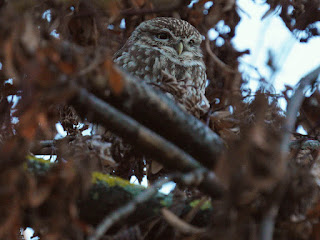A Mistle Thrush, some Redwings, a Blackbird and a Song Thrush collected at the rowan trees on Buck Hill to eat the fruit.
Of the thrushes that visit the park, only a Fieldfare was missing.
The female Little Owl was calling softly from the nearby squirrel drey.
The usual Jays followed me along the path. More of them are now coming down to snatch peanuts from my fingers in flight, a trick they made up themselves and have trained us to perform.
Farther down the hill a Carrion Crow turned over fallen leaves to see if there was an edible creature sheltering under them.
Andrew Fowkes told me that the female Peregrine has been perching on the northeast corner of the Royal Lancaster Hotel, a big tower block above Lancaster Gate Tube station with an ornamental concrete grille at the top. I think I saw her arrive carrying a pigeon and disappear behind the grille, but am not sure as my view was obstructed by trees. It's a place to keep an eye on.
A Blackbird at the edge of the Rose Garden ignored the din coming from the Winter Wasteland and foraged for insects and worms.
He found a millipede.
His mate perched in a tree above.
A flock of Long-Tailed Tits moved along the edge of the Long Water.
There are a reasonable number of Common Gulls on the Serpentine, but there are never as many as the other gulls here. Even at their favourite place, the Round Pond, you never see more than 50. Here are an adult, a young one, and an adult calling. The call is like a small version of the 'great call' of its larger relative the Herring Gull. Some ornithologists have suggested that Herring Gulls, Lesser Black-Backs and Yellow-Legged Gulls are all the same species and that the Common Gull is a subspecies of that, but it's a minority view.
Both the Grey Heron nests on the island have been occupied for several days. I think it's just two pairs of herons establishing their territory. I saw one chase another away when it got too close to the nest.
Two thin branches had Cormorants perched on them. I still haven't managed to see one land here. It must be a remarkable spectacle as the branch sags under the heavy bird's weight while it struggles to hold on with not very grippy webbed feet.
There were still quite a few Pochards on the Long Water, and also an arrival of Shovellers joining the single pair that has been here for some time.
A sawn-off tree near the Serpentine Gallery is hollowed out to a thin shell and has a big hole in its side. There must be a howling draught up the trunk when the wind blows. No wonder squirrels build themselves well insulated dreys of dead leaves.










Ring Ouzel also missing, not that they are often found. Jim
ReplyDeleteI've never seen one in the park. A rumour a few years ago turned out to be a Blackbird with white patches.
DeleteExcellent video of all the thrushes! Very neat and convenient to have them in one place. I love me some thrushes.
ReplyDeleteBut you can see how dark it is here on a day of thick cloud as we approach the winter solstice. The sun is setting at 3:52 pm and photography after 2 is near impossible.
DeleteI'm intrigued by your comment that a few ornithologists consider Common Gull a subspecies of the larger white headed gulls. In all my decades as a naturalist I've never heard that suggested once- where did you get that from? Seems totally absurd!
ReplyDeleteYellow-legged & Caspian were of course included in the Herring Gull complex until recently & no doubt a clinal relationship across the northern hemisphere between pale backed & dark backed large white headed gulls. Gull taxonomy is no doubt complex.
In recent years there's been an avalanche on gull books. The most recent, released here in the last couple of weeks is superb- Gulls of Europe, North Africa & the Middle East by Adriaens, Muusse, Dubois & Jiguet.
Wish I could remember where I saw that. It was in a newsletter a year or so ago, but I get newsletters from the BTO, RSPB and British Birds, and delete them after reading. The suggestion was mentioned but not further discussed.
Delete